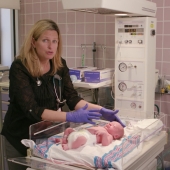A water birth means at least part of your labor, delivery, or both happen while you’re in a birth pool filled with warm water. It can take place in a hospital, a birthing center, or at home.
When a woman in labor relaxes in a warm deep bath, free from gravity’s pull on her body, with sensory stimulation reduced, her body is less likely to secrete stress-related hormones.
This allows her body to produce the pain inhibitors-endorphins-that complement labor. Noradrenaline and catecholamines, the hormones that are released during stress, actually raise the blood pressure and can inhibit or slow labor.
A laboring woman who is able to relax physically, is able to relax mentally as well. Many women, midwives, and doctors acknowledge the analgesic effect of water. Thousands of these mothers state they would never be able to consider laboring without water again.
Known benefits of water labor and waterbirth:
• Facilitates mobility and enables the mother to assume any position which is comfortable for labor and birth
• Speeds up labor
• Reduces blood pressure
• Gives mother more feelings of control
• Provides significant pain relief
• Promotes relaxation
• Conserves her energy
• Reduces the need for drugs and interventions
• Gives mother a private protected space
• Reduces perineal trauma and eliminates episiotomies
• Reduces cesarean section rates
• Is highly rated by mothers - typically stating they would consider giving birth in water again
• Is highly rated by experienced providers
• Encourages an easier birth for mother and a gentler welcome for baby
What are the risks to the mother and baby?
• You or your baby could get an infection.
• The umbilical cord could snap before your baby comes out of the water.
• Your baby’s body temperature could be too high or too low.
• Your baby could breathe in bath water.
• Your baby could have seizures or not be able to breathe.
- 2021 views













